by Ian Skellern
Here’s a prediction: the Urwerk synchronized AMC atomic clock/wristwatch launched in 2019 will take its place among history’s most significant timepieces.

Urwerk AMC
That’s a bold statement, I know. The complete timepiece – a slave wristwatch paired with a briefcase-sized atomic master clock coming in at 30+ kilograms – was presented at Baselworld in March 2018.
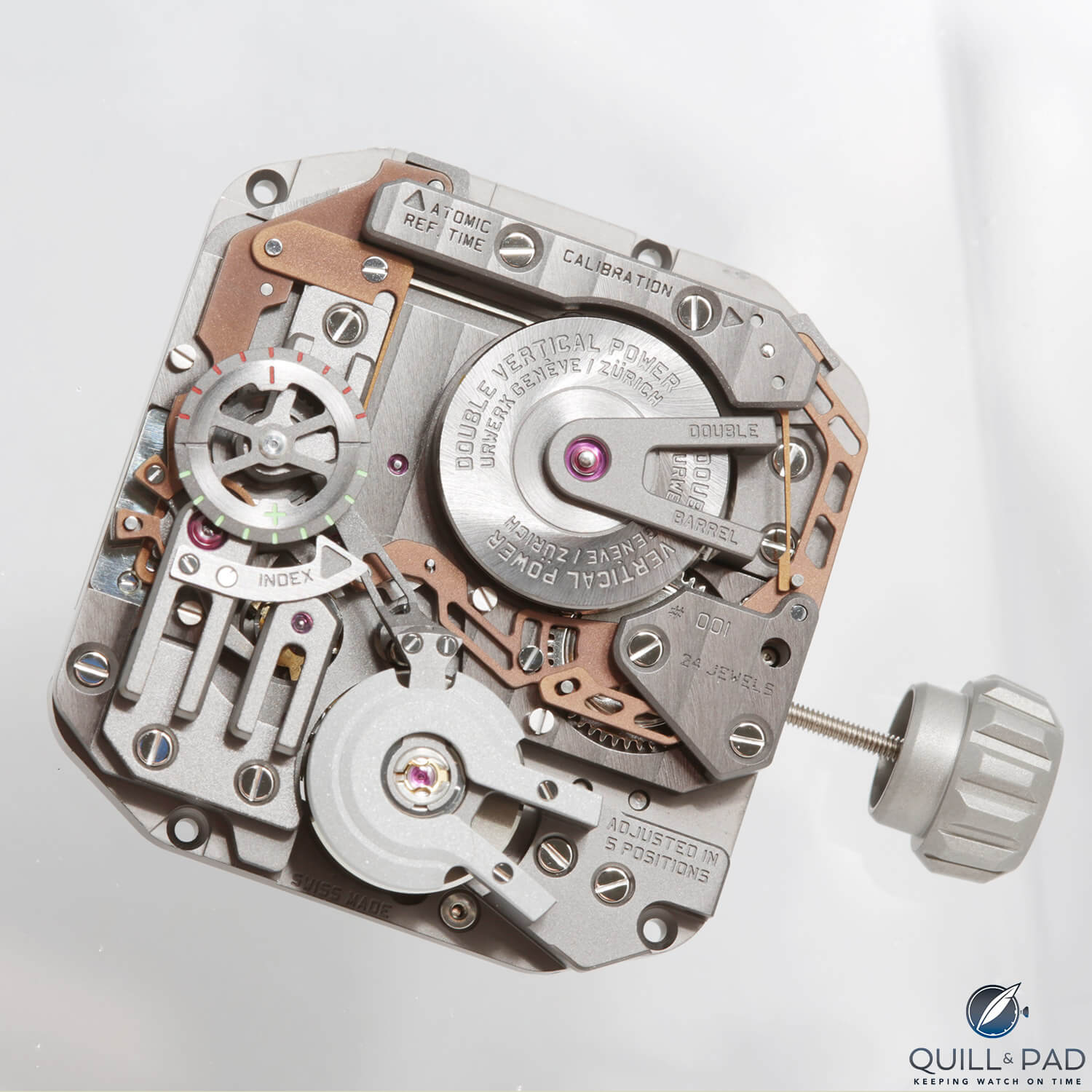
Urwerk AMC (Atomic Mechanical Control) wristwatch slave movement
At first glance, Urwerk’s AMC movement looks look similar to its EMC movement, but that’s deceiving: the caliber is 99 percent new (with only spring barrels in common).
The AMC wristwatch movement is an extreme evolution of the EMC, but not in the sense that the EMC movement has been upgraded but rather that the oscillator frequency went from 16,000,000 Hz for the Mega Quartz in the EMC to 429,000,000,000,000 Hz in the master atomic clock of AMC.
Compare both of those with an average modern mechanical oscillator beating at 4 Hz: 4 to 429,000,000,000,000 Hz!
And it cannot be stressed enough that, unlike EMC, the AMC wristwatch (slave) is 100 percent mechanical with a fully mechanical 4 Hz movement, no electronics at all. All communication between the atomic master clock and slave wristwatch is 100 percent mechanical.
Just as Abraham-Louis Breguet might have done in his day and, indeed, would have done if he could.
How it works: master and slave (to the rhythm)
Basically it works like this: you take your (slave) watch off at the end of the day and open the lid on an oversized “briefcase” containing an atomic (master) clock and assorted magical electronics and miniature robotics.
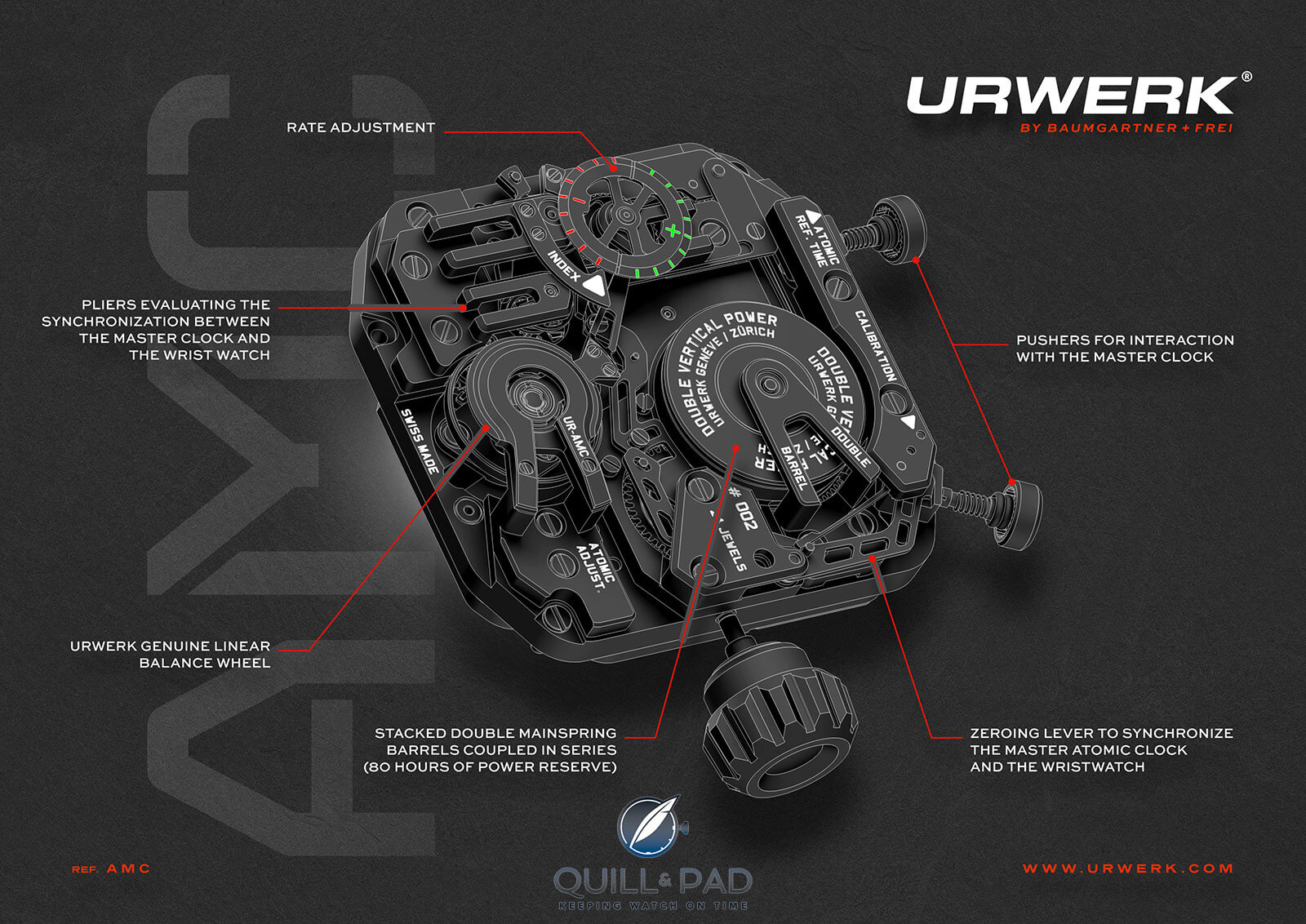
Uwerk AMC wristwatch movement
You place your watch on the dock inside it and a miniature probe from the master clock analyzes the precision of the slave watch and then adjusts the regulation of the escapement so that the precision will be better the next day. Each day the slave watch gets more and more precise, its accuracy timed by an atomic clock and the precision automatically adjusting to the wearer’s lifestyle.
There are three steps in this order:
1. The master clock adjusts the regulation of the wristwatch
2. The master clock sets the watch to zero by a mechanical signal that instantly resets hours minutes and seconds.
3. The slave watch movement is wound (it will not over wind) and all ready to go the next day.
If you remember nothing else from this article, hold on to the term automatic atomic rate adjustment. That’s a newly developed horological function by Urwerk that does exactly what it says on the label.
And that’s something Urwerk learned from the EMC project.
For me, the allure of AMC is the incredible contrast between a 100 percent mechanical watch and an atomic clock.
Past and future, tradition and modernity: that’s Urwerk in a nutshell.
Urwerk EMC (predecessor to AMC)
Urwerk’s EMC uses integrated electronics, a super capacitor, and a high-frequency quartz crystal to monitor the precision of the fully mechanical movement. The owner can then use that information to regulate the timing of the movement with a simple turn of a small screwdriver.
And I have absolutely no doubt that nobody ever thought, “That’s too much trouble, and wouldn’t it be good to have much higher precision than quartz?”
Nobody, that is, except Urwerk founders Felix Baumgartner and Martin Frei, which started a very long and very expensive passion project that is not yet certain to be commercialized.
But why a sympathetic clock?
Abraham-Louis Breguet Sympathique clocks
The development of the Urwerk AMC was inspired by Abraham-Louis Breguet’s Sympathique clocks, of which is he thought to have made five or six examples.
Breguet invented his Sympathique clock in 1795 and presented it for the first time at Paris’s Exposition Nationale des Produits de l’Industrie in 1798. His Sympathique clocks featured a paired system consisting of a clock and a pocket watch. The clocks have a cradle in which the pocket watch fits, where it was automatically adjusted and rewound.
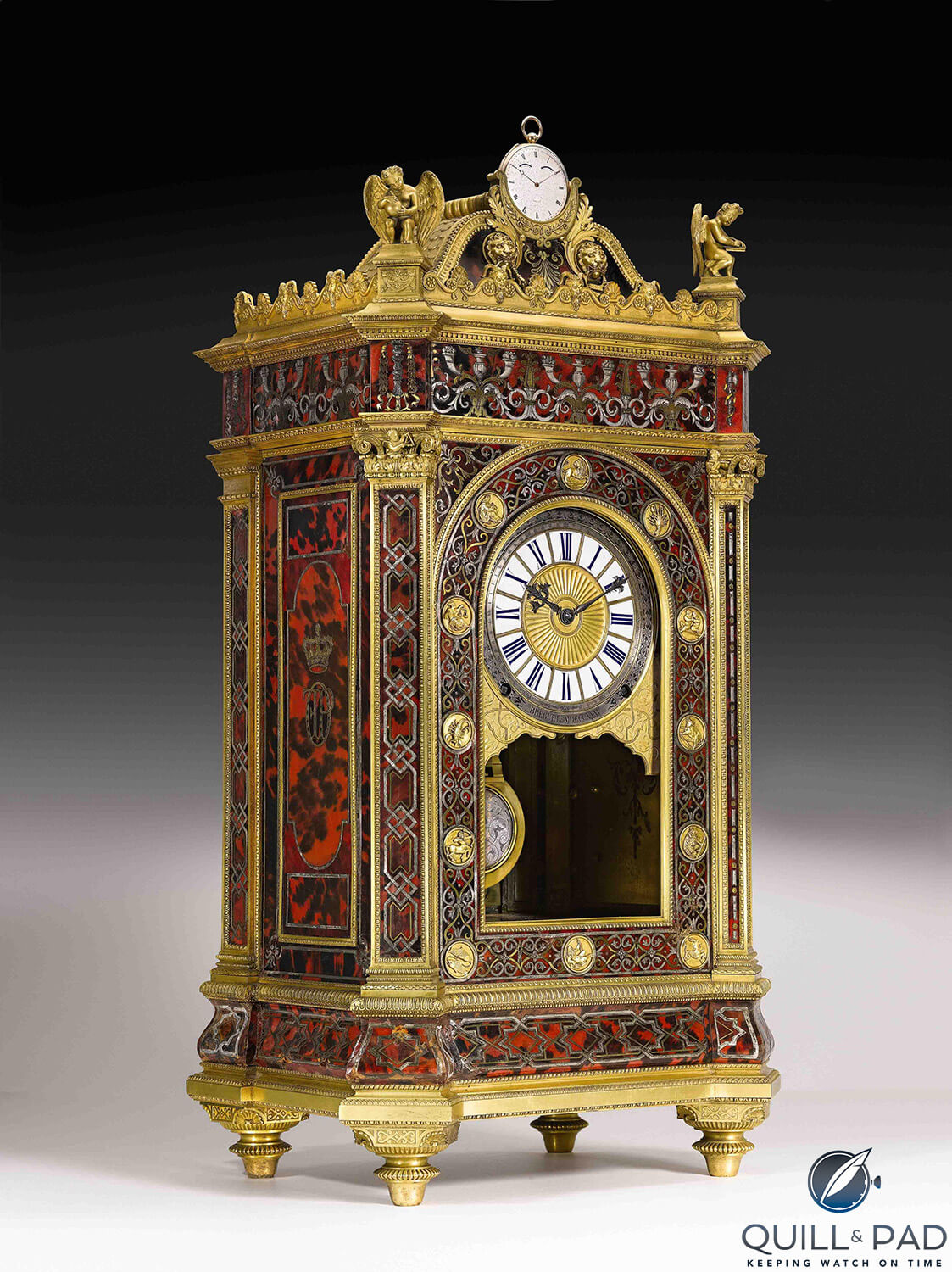
This Breguet Sympathique clock from 1835 for the Duc d’Orléans set a record price at auction for a clock when it was sold by Sotheby’s for $6.8 million
The word “Sympathique” was chosen by Breguet to express the notion of harmony and accord. Although not the most useful invention, the Sympathique clocks were Breguet’s most dramatic production.
Breguet explained to his son in 1795, “Then, every night on going to bed, you put the watch into the clock. In the morning, or one hour later, it will be exactly to time with the clock. There will be nothing visible externally to show where it has been touched. I expect from this the greatest promotion of our fame and fortune.”
* The Breguet Sympathique clock pictured above from 1835 and made for the Duc of Orléans set a world record auction price for a clock when it was sold by Sotheby’s for $6.8 million in 2012. It claims to offer all three functions discussed below, but that is now being verified.
Winding – Setting – Regulating
Breguet Sympathique clocks consisted of a master clock and a pocket watch. When the pocket watch was docked with the clock, usually once per day, two out of three of the following occurred (Breguet wasn’t able to implement all three in the one mechanism):
Winding: the pocket watch was automatically wound by the master clock.
Setting: the time on the pocket watch was automatically set by the more accurate master clock.
Regulating: the master clock automatically regulated the timing (fast/slow) of the pocket watch so that it became more accurate.
It’s worth noting that research indicates that only the last of Breguet’s original Sympathique clocks had a second hand. Each of Breguet’s Sympathique clocks was a unique piece, and they became more sophisticated as he learned from each completed clock.
It appears that the great man was well aware of the importance of his apparatus; in a letter to his son he excitedly wrote that he had made an incredible invention that could change everything.
This was one of the (if not the best) earliest examples of machine learning and artificial intelligence: the master clock could analyze the pocket watch and intervene to improve its precision.
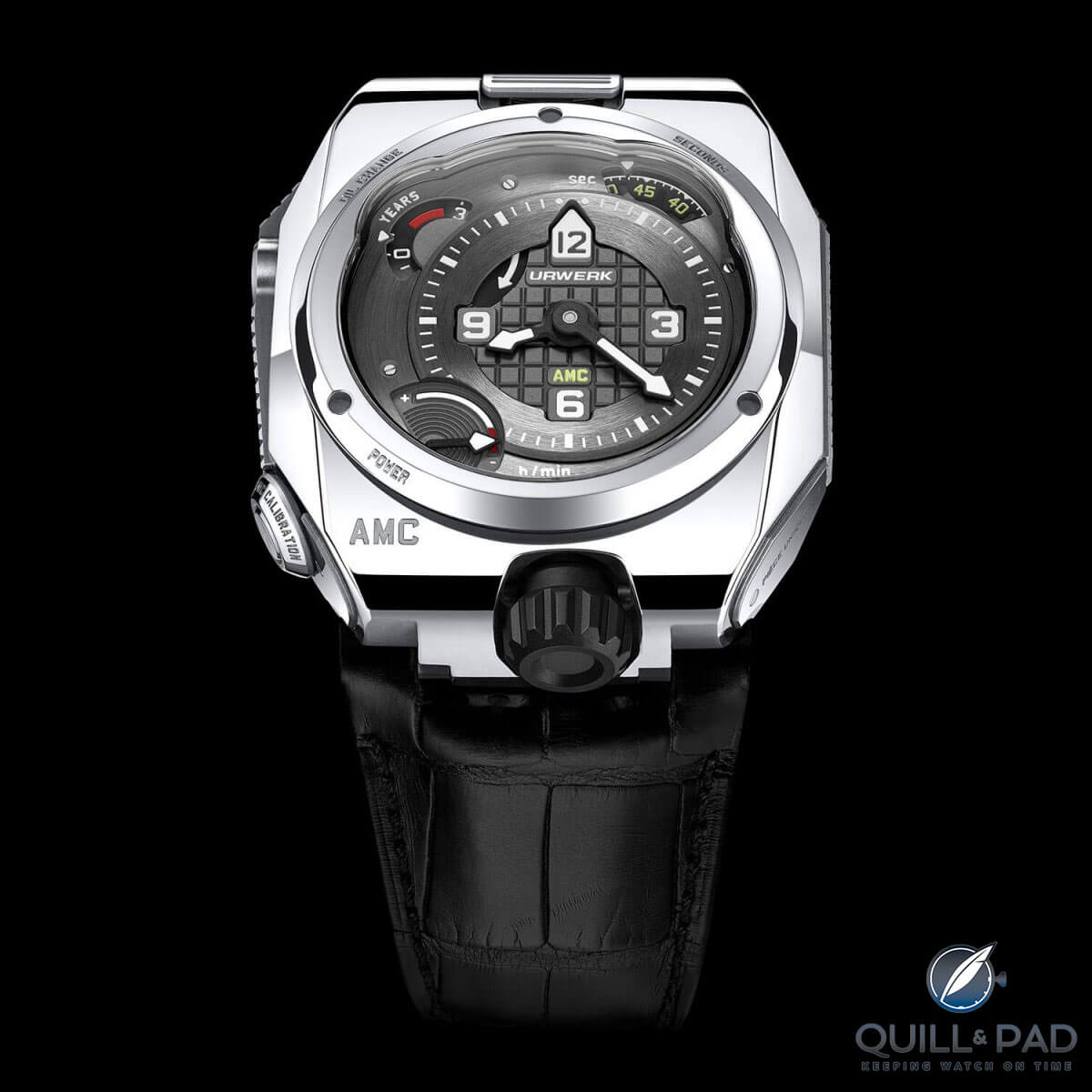
Urwerk AMC wristwatch
Urwerk AMC in perspective
In the 1800s Abraham-Louis Breguet (1747-1823) made five or six Sympathique clocks, all with two of three functions (winding, setting, regulating) as adjusting the timing was (and is) the most difficult to implement.
In 1850 Louis Breguet, son of Abraham-Louis (1804-1883), made 50 sympathique clocks, all with winding/setting functions, but no regulation.
In 1988 François-Paul Journe made a Breguet-inspired sympathetic clock for Asprey, with winding and setting functions only.
In the late 1900s three of the greatest living watchmakers – Vianney Halter, Denis Flageollet, and Journe – working together at the now-defunct THA, a company founded to develop complicated movements for high-end Swiss watch brands, spent ten years to create ten Sympathique clocks for the modern Breguet brand. Those ten all featured winding and setting functions only.
In 1997 Andreas Strehler presented his Tischkalender (desk calendar) master clock that had a dock for, and synchronized with, an accompanying slave pocket watch.
Urwerk’s AMC is the first time Breguet’s original Sympathique concept has been realized with all three functions – winding/setting/regulation – in the same master-slave clock system.
Then there’s that atomic clock.
AMC: Atomic Mechanical Control
As a young boy, Baumgartner spent a lot of time “helping” his father restore fine antique clocks in his home atelier. At an early age he learned how to appreciate the arts and crafts of the world’s finest horologists and about special complications.
But when Baumgartner’s father Geri explained to him about Breguet’s Sympathique clocks and showed him photos and illustrations of the seemingly mythical timepieces in books, it was with more than a hint of revered awe that he explained the communication between such high-precision machines.
Note: this isn’t the first watch Urwerk has developed from an idea originating with Baumgartner’s childhood in his father’s workshop. The UR-103 was developed in response to dad’s suggestion of making a watch that was easy to read on the wrist while driving.
“Why are the Breguet Sympathique clocks so fascinating for a watchmaker?” Baumgartner asked me rhetorically before going on to answer himself. “Because we don’t know how he did it. How do you even go about doing something like that mechanically?
“A watchmaker – this watchmaker anyway – wants to understand how something works, and the details of how Breguet managed to synchronize his master clock and pocket watch were a mystery. I’ve carried that mystery with me since childhood.”
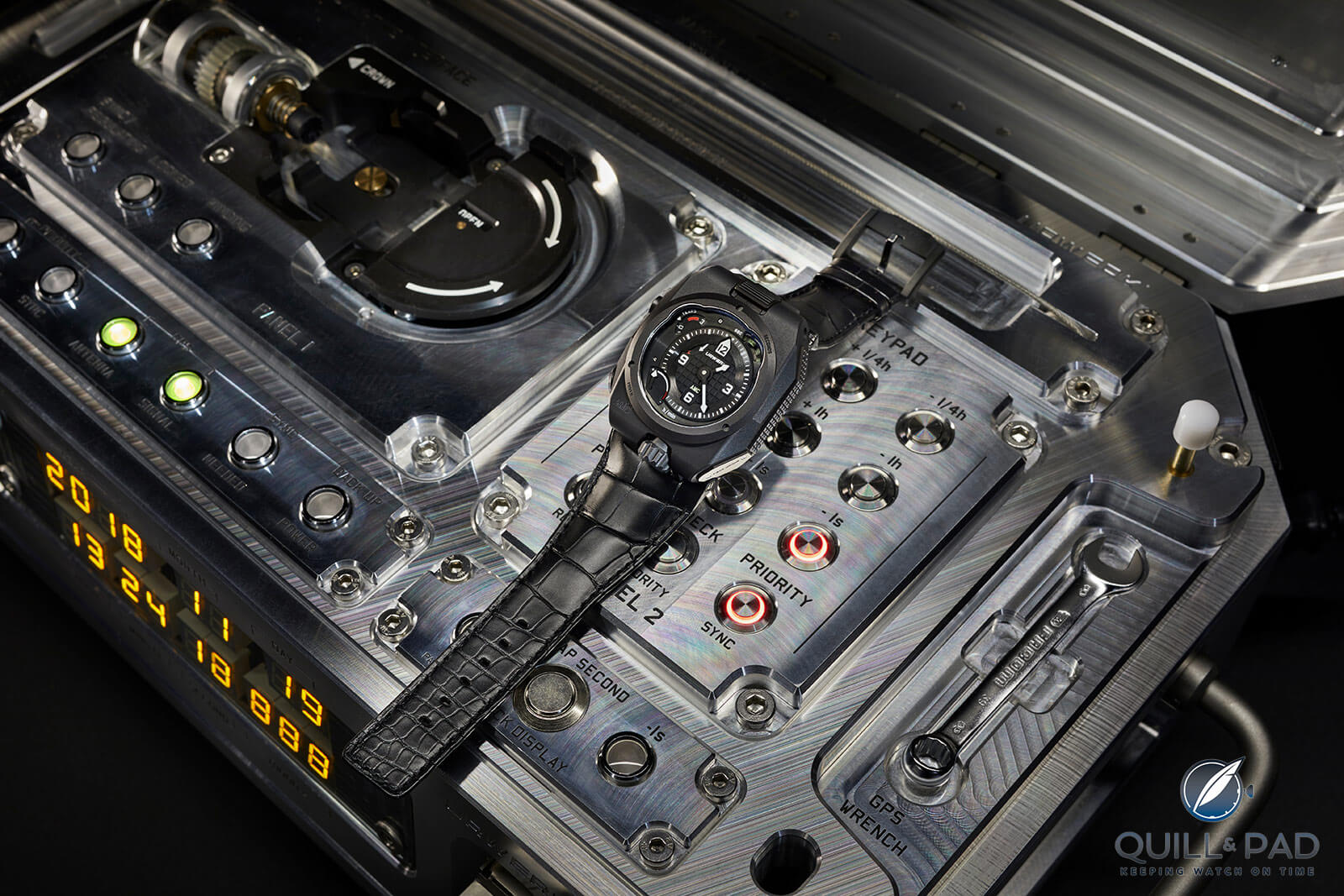
Urwerk AMC atomic clock
Then there was that atomic wristwatch geek
Around eight years ago, an electronics geek came to Urwerk with the idea to develop an atomic-regulated wristwatch together. Baumgartner and Frei thought the idea interesting but preferred to continue on with the 100 percent mechanically regulated clockwork.
Atomics just wasn’t Urwerk’s field. And that was that. And the years passed.
Until Baumgartner thought, “What if we replicated Breguet’s Sympathique clocks, but make it for today by using – as he did – one of the most accurate clocks existing at this time as the master clock: an atomic clock. Our master clock would be an atomic clock.
“And, just as the slave/sympathique part of the duo was one of the smallest and portable for the time, we would synchronize the atomic clock master with a wristwatch slave.
“Theoretically, at least.”
Urwerk’s raison d’être
In an earlier article called Urwerk Vs. MB&F: How Do They Square Up?, I wrote: “. . . despite their shared ‘futuristic’ visual similarities, the basic raison d’être of Urwerk and MB&F are not just fundamentally different; they are 180 degrees opposed.”
Baumgartner, Urwerk’s co-founder and head technician, is a third-generation watchmaker following in the footsteps of his father and grandfather. For Baumgartner, Urwerk’s space-age designs and unusual indications are a way of breaking out of the constraints imposed by traditional haute horlogerie.
For Baumgartner and Urwerk co-founder and chief designer Martin Frei, Urwerk is a platform for escaping the past while remaining attached at the roots. Urwerk primarily focuses on inventing new complications; the brand’s avant-garde designs play an integral, but supporting, role to the mechanics.
UR-AMC: a bridge between then and now
Baumgartner explains, “The big mountain for us was how to do the regulation: the atomic master clock would have to integrate the mechanical balance of the wristwatch, determine by how much it was either fast or slow against the 429,000,000,000,000 Hz atomic master oscillator, and adjust the timing accordingly, learning from each interaction so that the wristwatch becomes more and more accurate per day.
“An atomic clock/Sympathique wristwatch to me is a bridge: we are using a mechanical wristwatch – a fully mechanical wristwatch – to go between one of the greatest horological inventions of the eighteenth century (Breguet’s Sympathetic clock) and the greatest precision clock of today (the atomic clock).
“We had to develop an electronic/mechanical interface between the atomic master clock and the AMC wristwatch that would allow the master clock to precisely analyze the mechanical regulator in the wristwatch, but also be able to mechanically intervene and adjust the precise timing of the balance wheel’s oscillations.”
The problem with an atomic oscillator-regulated wristwatch is energy: it needs a lot of it. You may not be at all surprised to learn that measuring and interpreting data from decaying atoms demands a lot of power, much more power than can be comfortably worn on the wrist for any length of time.
And with an atomic watch, imagine airport security! But don’t worry, plenty of people are likely to pull phones out when the alarms go off, so you can watch it on YouTube at your leisure.
While the atomic master clock is the manageable size of a large briefcase, it does weigh a deceptively heavy 30+ kilograms. It can be transported, but isn’t considered portable.
The Urwerk AMC was not a commercial venture
“AMC is an horological adventure, not a commercial venture,” revealed Baumgartner. “We – and I speak for us all as the whole team at Urwerk was behind this project – developed AMC because we believed in the project, but the substantial investment in both money and time are unlikely ever to be recovered.”
But Urwerk’s team was somewhat consoled as this innovative milestone invention won the Audacity Prize at the 2019 Grand Prix d’Horlogerie de Genève.
Urwerk made a total of four AMC atomic clocks and paired wristwatches and there will be no more. As of March 2021, three were sold and delivered, one at Phillips’ fall 2019 auction, where it hammered for the astounding price of $2,900,000.
Urwerk is keeping the fourth example for itself.
For more information, please visit www.urwerk.com/collections/ur-chronometry/amc.com.
You might also enjoy:
Urwerk Vs. MB&F: How Do They Square Up?
The Difference Between Urwerk’s EMC And A Toyota Prius (Not As Obvious As You May Think)
Back In Black: First Live Photos Of The ‘Smart’ Urwerk EMC Black





















































Leave a Reply
Want to join the discussion?Feel free to contribute!